Cross Lowered, Seeks New Place to Rise
- Share via
Caltech, known for its scientific studies of the heavens above, launched a successful earthly operation Thursday when a pair of cranes tugged a towering cross off the dome of the school’s latest real estate acquisition.
Now the California Institute of Technology has a new problem to solve: What to do with a hulking, rusted religious icon?
For decades the illuminated cross was a beacon at St. Luke Medical Center in Pasadena. Caltech officials tried to give it to its original owners, the Sisters of St. Joseph of Orange, who built the hospital in 1933 and sold it nearly 20 years ago. But the sisters passed.
“Quite respectfully,” said Sister Suzanne Sassus, a senior vice president of the St. Joseph Health System. “The fact of the matter is we don’t have a place to put a 17-foot cross.”
Frank Hall, another senior vice president, went out to survey the cross’ salvage potential. Too big. Too expensive to move.
“It’s not the kind of thing you can put in a storage locker,” he said. “What the sisters have suggested is that if Caltech would give it to a church, they would be very happy.”
Being a big old cross from Pasadena carries some cachet in a city where historic preservation is a civic pastime. Not wanting to evoke the ire of preservationists or the religious, Caltech decided to spend $9,000 to remove the metal cross and keep it in a campus garage until someone stepped forward to offer it a nice Christian home.
“We want to do good by it,” said Rick Cally, the Caltech facilities manager in charge. “It is a cross, you know. It’s not like an air conditioning duct.... We want to find it the best possible home.”
Caltech announced in May that it would buy the hospital, a city-designated landmark that closed last year, from Tenet Healthcare Corp. The school is renovating the medical center for use in such fields as astronomy. The main building features a Spanish-style dome, terrazzo floors and elaborate stairways. Also on the 13-acre grounds are two smaller structures: a chapel with stained-glass windows and a former convent.
But the cross was not an appropriate symbol for Caltech. It was not the hospital’s original 1933 wrought-iron cross either.
Instead, in 1965 the hospital installed a sheet-metal cross with opaque plastic facing, and for years it was illuminated like a light bulb from the inside. Later, spotlights on the roof shone on the cross.
The city issued Caltech a permit Wednesday to remove the icon because it was not considered historically significant.
But the cross didn’t fall easily.
First, there was a huge beehive inside a support collar at its base. A pest control company was called out. Then the workers sawing the cross down had to don full bee-protection jumpsuits, complete with nets over their heads. When they went to cut, rusty water poured from a support pipe, further delaying the operation.
Shortly after 1 p.m. the crane wiggled the cross from its base and gently lowered it onto a flatbed truck.
Longtime hospital neighbor Elsie Purnell, 68, showed up to witness the event with her camera. She called it a form of therapy to ease her sadness over seeing a cherished landmark go.
“It’s like they are removing the Hollywood sign,” she said, snapping photos of the cross lying on the truck. “It’s very sad for me. Very sad.”
Another neighbor was there to capture the action in photos. He agreed that Caltech should not have a cross on the building.
“A globe would be appropriate,” said Don Valentine, 77.
“Or how about a globe of Mars,” suggested his wife, Eleanor, also 77.
The cross showed signs of rusting and corrosion inside and is closer to 14 feet in length than the previously estimated 17.
Caltech spokesman Bob O’Rouke said the school will honor the sisters’ wishes and hopes to give the cross to a local church. He said that he had already received several inquiries but that no decision had been made.
So, for a free cross, call (626) 395-3685. Taker must accept it “as is” and provide transportation to its new home.
More to Read
Inside the business of entertainment
The Wide Shot brings you news, analysis and insights on everything from streaming wars to production — and what it all means for the future.
You may occasionally receive promotional content from the Los Angeles Times.










